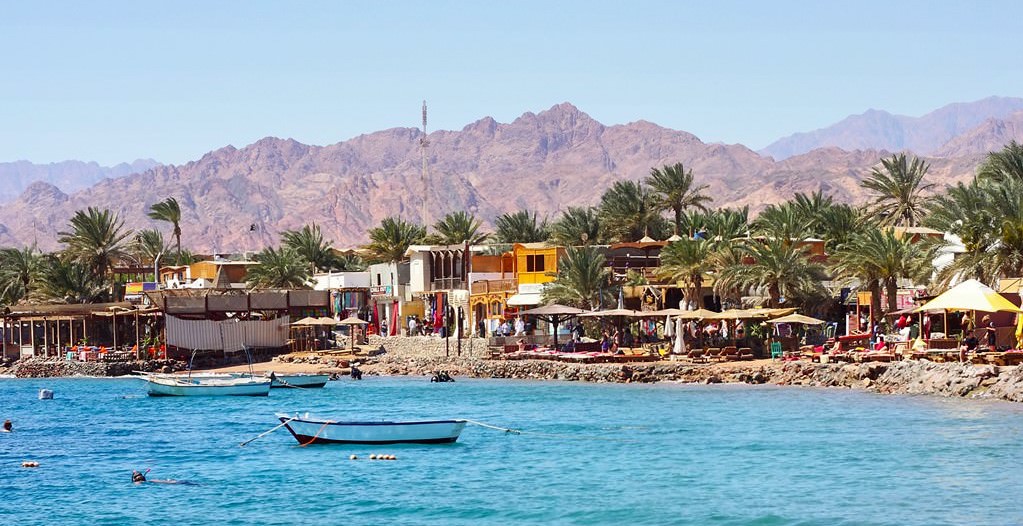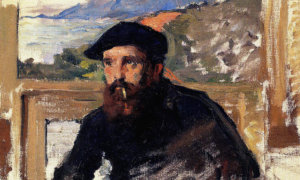The Red Sea towns in Sinai such as Sharm El-Sheikh and Dahab are probably the most visited destinations in Egypt. It is often the case whenever I tell somebody from Europe that I am Egyptian that they tell me, “I have been to Sharm El-Sheikh before.”

Sharm El-Sheikh, one of the most popular resort towns in Sinai, is famous for its incredible reefs and beautiful fish which makes it a top world-wide destination for diving and snorkeling. Budget airlines used to fly frequently from Europe directly to Sharm El-Sheikh, and some airlines still do.
However, I prefer the less-known town of Dahab which is 80 kilometers northeast of Sharm El-Sheikh. Dahab is a small town which used to be a Bedouin fishing village and is now a prominent diving destination. Something about the shorelines, the mountains and the scenic nature affect the temperament of both its locals and visitors.
Dahab is a place where things feel serene. Life takes a different pace from anywhere else in the world.
As someone who is always pressed for time and who is always rushing around from one point to another, I was surprised at how much more calm I was in Dahab.
It is true that being on a holiday would slow anyone down, but there is something about Dahab which makes you active and chill at the same time.
In four days in Dahab, we snorkeled in two different spots, went to a Bedouin night in the mountains, explored the natural reserve of Abu Gallum, tried out a few restaurants (serving freshly caught fish and seafood), listened to live music, went shopping and one of our friends even managed to go diving.
Moreover, we even had time to sit around and do nothing in front of the beach for hours drinking a very cold juice of amazing Egyptian mangoes.
Blue Hole
Dahab’s Blue Hole, a diving spot famous among divers worldwide, was our first snorkeling spot. It has an abundance of coral reefs and fish species. Diving centers, which are spread all over Dahab, organize diving and snorkeling trips to the Blue Hole on a daily basis.
It is not an easy spot for diving.
The Blue Hole is known for being quite dangerous as it requires significant diving expertise. However, some divers are also drawn to the challenge the Blue Hole posits due to its 26-meter-long arch under the water. As for snorkeling, we have not seen anything more beautiful before. The colors, sizes and shapes of reefs and fish were beyond imagination. We saw things we did not know existed.
The crazy thing is that it only costs $10 per person to enter the area of the Blue Hole!

Ras Abu Gallum
Another incredible snorkeling spot is the nature reserve of Ras Abu Gallum north of Dahab. The proximity of the mountains to the beach in Abu Gallum is not the only attractive aspect of the nature reserve.
There is also a variety of species of sea creatures and coral reefs which we explored with a guide who took us snorkeling there. We went to Abu Gallum by boat from the Blue Hole. However, when it is less hot, the route between the Blue Hole and Abu Ghallum could also be done on the back of camels. Local Bedouins showed us incredible hospitality and took care of every step of the trip along with our snorkeling guide.
The Blue Lagoon was our favorite beach. It is a sheltered pond of clear, shallow, relaxing water. The lagoon is a haven for kite-surfers as well due to its calm water and beautiful scenery. We could not access the beach on our own as it requires some driving with special cars in the middle of nowhere.
However, it was easy for us to get there as we had a safari company arrange our transportation with local Bedouins who drove the right cars and knew their way around. The whole day’s activities were only 350 Egyptian pounds per person, the equivalent of $19 (hot lunch and transportation included).
This comprised a lift from the hotel to the Blue Hole, having a snorkeling guide all day in both the Blue Hole and Abu Ghallum, being taken on a speed boat to Abu Ghallum, then in a truck from Abu Ghallum to the Blue Lagoon, then back to the boat, then back in a car to the hotel.

Star gazing
For me, stargazing in the mountains of Dahab was the highlight of my trip. This was made possible for us by the same company we used for the snorkeling trip. For the equivalent of $6 each, we were taken by a guide at night through some mountains where we found a beautiful Bedouin camp with fire, lanterns, and live music.
Musicians sat with their Oud and Douf (traditional instruments in Arabic music) and played all night while people sang along. However, a two-minute hike up took us to the edge of a cliff where surprisingly the music seemed to come from far far away.
It was very quiet. The sky had many stars. We could see constellations which would have been impossible to spot elsewhere. We were served Bedouin tea (included in the $6) and lay on comfortable kilim rugs and cushions watching the stars, listening to the far away music for hours.
Some of us fell asleep as the gentle evening wind of the mountains stroked our faces till the guide came to take us back to the hotel after midnight. That night I slept so well.
I do not even remember the last time I slept like that.
The world has so many interesting holiday destinations to offer outside the Italian Amalfi coast, Greek islands and the French riviera. Dahab gives you sparkling waters with their calming waves rolling onto shaded beaches, authentic live music from across Egypt and some of the best glimpses at a submarine paradise you would not find anywhere in the world.
–––––
Sarah recommends Action Safari Dahab. You can contact them through their Facebook page here.
Dahab with Vito is one of Dahab’s most famous tour guides. And he’s a dog. Vito (and his master) accompany people on hiking trips, Bedouin nights and other adventures. You can see their Facebook page here.
For lodgings, Sarah recommends Dar Dahab Hotel, an eco-friendly facility operated by a Swiss-Egyptian family right on Assalah Beach.
Sarah Nagaty has a PhD in cultural studies, She’s lived in Portugal for six years.
As a student of cultural studies, Sarah is drawn to what connects people from different backgrounds to new cultures and places, how they relate to their new surroundings and what kind of activities they could engage with in their new hometowns.















